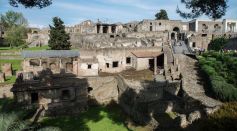Tags: Archaeology

3000-Year-Old Canoe Found in Wisconsin, Claimed To Be Earliest Water Transportation Vehicle Used by Ancient Tribes

Archaeologists Are Getting Closer to Determining the Mystery Date of the Infamous Thera Volcano Eruption in Greece

Queen Nefertiti's Mummy To Be Revealed In Upcoming Month or Two, Egyptologist Says

New Pompeii Discovery: Archaeologists Find Ancient House That Offers a Glimpse of Middle-Class Life

400-Year-Old Italian Mummy Provide Insights About the Mysterious Evolutionary History of E. Coli

Egyptian Pyramids Mystery Unveiled: What’s Inside? How Rich Were the Ancient Tombs of Pharaohs?

Machu Picchu History Shows Name a Mistake By Local Farmer, Now Experts Are Trying to Correct It

England Archaeological Site Discovered with Rare, Well-Preserved 'Time Capsule' from Iron Age

Tomb of Woman in Dolmen of El Pendon From 3000 BC Showed Signs of First-Ever Ear Surgery

Hopewell Culture May Have Been Ruined by Comet Explosion 1,500 Years Ago

Archeology: Ancient Humans Farmed Vicious Cassowaries, Thousands of Years Before Raising Chickens
World's Oldest Known Archaeological Site Candidates From 2.5 Million Years Ago, Make Giza Pyramids, Stonehenge Seem Young
Neanderthals Are More Advanced Species; Studies Show Complex Tool-Making Techniques, Excellent Working Memory

1,600-Year-Old Sheep Mummy Reveals Husbandry Practices in Ancient Iran
Taking the High Ground: Ancient Roman Camp Used to Reach Northwest Iberia Found
Young Neolithic Artisans: 5,000-Year-Old Pots With Three Fingerprints Crafted by Two Young Males

Shrunken Head Rediscovered, Returned to Ecuador; Believed to be Slain Enemies with Skulls Removed

Remains of 9 Neanderthals Found Near Rome, Offering Insights on Prehistoric Population
Pint-Sized Dinosaur from Mongolia Has Eye Vision Like an Owl at Night
160-Year-Old Medicine Box From Japan Contains Toxic Chemical; Muon Scanning Reveals Contents
Most Popular

Why Stars Twinkle: Flickering Explained by Atmospheric Turbulence and Light Distortion

The Role of Materials Science in Engineering: How Modern Engineering Materials Drive Innovation

Tornadoes vs. Waterspouts vs. Dust Devils: Key Differences and Vortex Types Explained

Climate Adaptation Strategies Explained: How Societies Respond to Climate Change





